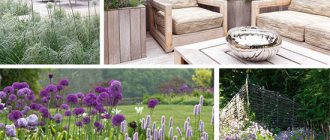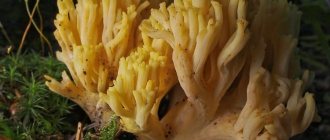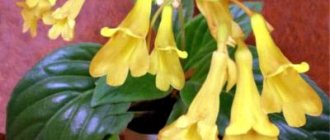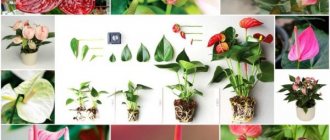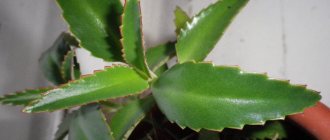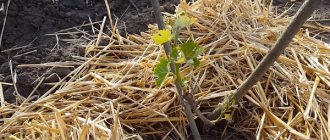The flower called staghorn is properly called Platycerium and is a fern. Deer antlers, it was named for the whimsicality of its leaves, they really resemble horns.
Flower growers love the flower for its unpretentious maintenance and decorative properties, which are due to the bright greenery of the plant. The fleshy light green leaves of Platicerium, covered with a light waxy coating, are heavily dissected. Let's talk about how to properly care for this plant at home.
Biological description of the Deer Antlers flower
It has leaves (vai) of two types : sterile and spore-bearing. Sterile fronds form a funnel in which nutrients accumulate over time. They can be dead parts of the plant itself, seeds and leaves of other plants that have fallen into the platycerium funnel.
Indoor flower Deer Antlers
Spore-bearing fronds can be erect or drooping. They are reminiscent of deer antlers. There is no color on the plant because ferns do not bloom.
Botanical description
Kalanchoe Laciniata belongs to a diverse species of succulents, that is, “water-storing” plants, and belongs to the Crassulaceae family. There are more than 200 species. The homeland of clananchoe is considered to be South Africa and Asia, the tropical places of South America. Kalanchoe Laciniata is a perennial herbaceous plant , the shoots are succulent, fleshy, at first erect, then, as they grow older, they become lodging, and then, over time, they become completely bare below.
The leaves are original, deeply dissected, serrated at the edges, light green, bright in color, as if covered with wax. This species is not as popular as other, more colorful Kalanchoes. But for its branched, carved, bright leaves, this Kalanchoe is very much loved by lovers of exotic flowers. The flower is unpretentious and quite easy to care for.
Fern care
Humidity and watering
Platicerium, like all ferns, loves abundant watering and high humidity.
It should be remembered that the flower cannot be watered with running water. Water for irrigation must be warm enough and must be settled or boiled.
With all the love for high humidity, you should also ensure that moisture does not accumulate in the pan. Overwatering can lead to rotting of the root system and overall death. He really likes frequent spraying in the summer. Spraying is also carried out with pre-purified or boiled water.
It is necessary to water 1-2 days after the top layer of soil in the pot has dried . Often novice gardeners are too zealous with watering.
Platycerium requires very high humidity; it should be sprayed with warm boiled or purified water
In winter, water less frequently, about once every 10 days . It is better not to spray in winter. If the room is dry, you can place a wide container of water next to the fern.
The flower cannot be wiped. Its leaves are covered with small hairs that absorb oxygen from the air. Wiping the plant with a sponge or rag can easily damage them, which will lead to death.
Temperature and lighting
Deer antlers prefer diffused lighting and a fairly high room temperature. Does not tolerate direct sunlight. It is best to place the flower on an east or west window.
Optimal temperature is from +20 to +25°C . But the flower can easily tolerate temperature fluctuations. In summer it can easily withstand higher temperatures up to +32°C, and in winter it can exist at temperatures from +12-14°C. In winter, a phytolamp can be used to create sufficient illumination.
It should be borne in mind that the plant does not tolerate drafts.
Soil and fertilizers for flowers
Soil composition for optimal growth and development of Platycerium:
- sand 1 part;
- leaf soil 1 part;
- peat 2 parts
- mixture of moss and fine pine bark 1 part
Platicerium grows well in substrates that include peat, leaf and coniferous soil, crushed sphagnum in proportions 2:2:2:1.
Excellent for Deer antlers, ready-made mixture for orchids. You can buy it at a flower shop.
Fertilize every month with complex fertilizer for ferns. Experienced gardeners recommend using half the dose indicated in the instructions . There is no need to apply fertilizer in autumn and winter.
Quality of soil mixture
Bulbous flowers for the garden and indoor plants
Laciniata can be planted in a ready-made store-bought substrate intended for cacti and succulent vegetation. It is moderately nutritious, light, and allows water and air to pass through well.
But many gardeners prefer to prepare mixtures themselves:
Recipe No. 1
The following ingredients are mixed in certain proportions:
- 1 part turf;
- 1 part leaf soil;
- 1 part coarse river sand;
- A quarter of vermiculite.
Recipe No. 3
Another recipe that includes not quite standard materials that need to be taken in equal volumes:
- Light loam.
- Coconut substrate.
- Zeolite cat litter.
It is recommended to add a small amount of pieces of birch charcoal and humus to any composition. A thick layer of drainage material should be placed at the bottom of the pot: medium expanded clay, gravel, small pebbles, pieces of polystyrene foam, clay or ceramic shards. Drainage eliminates stagnation of moisture at the rhizome and reduces the risk of rotting.
Diseases and pests
Deer antlers, the flower is quite resistant to diseases and pests. More often it starts to hurt from improper care .
- The leaves have lost their elasticity and become lighter in color . Most likely suffers from exposure to direct sunlight. The plant should be shaded. Platicerium reacts to sunburn by the appearance of dark spots on the leaves.
- The leaves began to dry . This is how the flower reacts to lack of moisture.
- The leaves began to fade . Excessive watering is to blame.
- Shield . These pests must be manually removed or washed off. It should be remembered that you should not wipe the leaves of deer antlers, so as not to damage the hairs that cover the leaves.
Indoor Platycerium is susceptible to scale insects, and caring for it is complicated by the fact that it must be removed manually
- Spider mite . If affected by this pest, it is necessary to treat with an insecticide.
- With excess humidity in high temperature conditions, platycerium can be affected by powdery mildew . With this disease, it is necessary to treat the leaves with a fungicide.
When handling drugs, you must use protective gloves. It is advisable to carry out the treatment outdoors.
How to properly care?
Watering for Kalanchoe Laciniata should be moderate. We monitor the condition of the top layer of the substrate - when it dries completely, watering is required.
- In summer, on especially hot days, we water 2 times a week in small doses.
- In winter, we reduce watering, once every 7-8 days is enough; Kalanchoe Laciniata can get sick if over-watered, and is prone to rotting of the trunk and leaves.
We water only with settled or purified water. Water can be poured into a tray so that it does not fall on the leaves.
With a lack of moisture, Kalanchoe Laciniata loses its leaves. Shriveled leaves are a sign of lack of watering. But even on summer days the flower does not require spraying. Temperature . Kalanchoe Laciniata tolerates heat well. The temperature in summer is up to 28 - 30°C, in winter the required air temperature is 12 - 15°C. The most optimal temperature for keeping a flower is 17 - 18°C.
Features of care in summer and winter
Platycerium does not have a pronounced dormant period. From October to February the flower should be allowed to rest. With sufficient lighting, the temperature for the flower in winter is +15-17°C . During this period, the plant is not fertilized or sprayed with water. Watering should be reduced, but the earthen clod should not be allowed to dry out completely.
In summer, watering is increased. You can moisten the plant by immersing the container with Platicerium in water for a few seconds.
Lighting needs and location
Kalanchoe laciniata is photophilous and requires bright light for normal growth. It is best to place the succulent on east, west, southeast or southwest windows. The north side is the worst for deer antlers, as well as the south - here it will need shading from the intense midday sun.
If the flower overwintered in a room with insufficient lighting or the winter turned out to be little sunny, then at the beginning of spring it should be gradually accustomed to direct sun, since intense rays can burn the delicate leaves of Kalanchoe.
It is important! Due to the fact that Kalanchoe deer horns have a very original appearance, some owners place the flower in the back of the room to decorate the interior. This is a completely acceptable option, but with certain conditions. First of all, the frequency of watering is reduced. And the plant’s stay in a semi-shaded place should not be longer than 3 weeks, since without natural light the succulent will wither.
Reproduction methods
Disputes
This propagation method is practically not used in home floriculture, since it is very labor-intensive and often does not produce results.
The spores, which are located at the ends of the spore-bearing fronds on the underside, must be collected and dried. The spores are then placed on the surface of the soil. There is no need to cover them with soil. You should systematically moisten the soil and cover the top of the container with glass or film.
The first leaves of the Staghorn fern when propagated by spores will appear in 2 months
To develop into adult plants, spores need plenty of sunlight and high humidity.
Offspring
This method of reproduction is much simpler. Periodically, young shoots appear on an adult fern. You should wait until the roots have developed sufficiently and carefully separate the young shoot. It should be placed in prepared soil. Complete rooting of the offspring occurs in 2-3 weeks . The appearance of new leaves is a sure sign that the plant has taken root.
Dividing the bush
The easiest way to propagate the Staghorn fern is by dividing the bush when replanting.
When replanting, you can propagate the plant by dividing an adult flower. It is necessary to ensure that when dividing, both parts of the plant retain the roots and fronds of both types . Otherwise, the plant will die.
Where and how to plant?
We replant young Kalanchoe Laciniata once a year:
- We treat the pot to prevent disease.
- At the bottom of a small pot we place drainage - pebbles, expanded clay, pieces of cut cork, 4-6 cm.
- Lightly, without trampling, pour in moist soil.
- We deepen it to the level of the neck, making a small depression.
- We fertilize the soil.
An adult flower is replanted every 3 to 4 years as needed.:
- They use the transfer method.
- The pot requires a larger size than the previous one.
- At the bottom, one third of the volume of the pot, pour a drainage base - expanded clay.
- We place the root shallowly together with an old lump of earth.
- Fill the space in the pot with new soil.
- We apply fertilizers.
Adaptation after transplantation usually does not last long - 1 - 2 weeks . A shallow pot is suitable, since Kalanchoe Laciniata has a weak root system. Be sure to place a thick layer of drainage base at the bottom of the deep pot to prevent root rot.
Useful properties of deer horns
Deer antlers perfectly purify indoor air. They saturate the surrounding air with phytoncides, which have a beneficial effect on humans. In addition, deer antlers actively absorb hydrocarbon compounds from the air . For example, they perfectly purify indoor air from gasoline vapors and automobile exhaust gases coming from the street. This ability of the flower is becoming very popular, thanks to the increased number of cars on the streets of our cities.
Reproduction of platicerium or flathorn
At home, ferns reproduce by lateral shoots that form between the overlapping leaves. Young platyceriums grow between the leaf blades, which makes it very difficult to separate them. Therefore, the procedure for separating the shoot is carried out during transplantation, using a sharp knife very carefully, trying not to damage the leaves. The separated young flathorn is planted in a separate container as an independent plant. Until the fern takes root, it is placed in a greenhouse in order to create a favorable level of air humidity.
Platycerium bifurcatum.
At home, this fern is not propagated by spores, due to the particular difficulty of caring for seedlings.
Difficulties in growing
Platiceriums are grown in a suspended state or on pieces of bark, stumps, in wooden or plastic baskets, in pots.
Beginning gardeners sometimes have difficulty watering and propagating deer antlers. In addition, experienced flower lovers advise placing deer antlers in a suspended state . After all, this is exactly how it exists in its natural environment. To do this, you can use a small log in the recess of which is filled with moss and a flower is fixed. A piece of bark can be used for the same purpose.
You can stick several knitting needles or thin sticks into the flower pot and carefully secure the heavy leaves so that the flower does not fall under their weight.
General information:
Deer horns (Kalanchoe laciniata)
– Because of the unusual shape of the leaves, the plant is called Deer Horns. The plant is classified as an indoor plant and is quite unpretentious. Native to Africa, subtropics and tropics of Asian countries.
A perennial herbaceous representative with a succulent fleshy shoot, initially erect, then lodging; the plant becomes bare below with age. The leaf is fleshy, deeply dissected, serrated at the edges, light green, and has a waxy coating. The flower is tubular, yellow-orange.
Deer Horns bloom profusely. The soil for the plant is turfy-sandy. In autumn and winter, watering is limited, after the soil has completely dried. Thanks to the shoots that droop over time, it can be grown as an ampel plant.
The leaves of different species differ from each other. Often thick, strongly or slightly dissected, may be sessile, or may have petioles. The red, white or purple flower is collected in an umbellate inflorescence.
Types of Platycerium
Double-forked
Double-forked Platicerium
This type of flower is also called moose-horned. The double-forked platycerium received this name for its very large leaves, which really resemble elk antlers. Reaches 45-75 cm in height and the same in width . Under natural conditions, the double-forked platicerium reaches such a size that it can fall under its own weight.
Hilla
Platycerium Hilla
Similar to double-forked but with more modest leaf sizes. If the leaves of the double-forked platycerium resemble the antlers of an elk, then the fronds of the platycerium hilla really resemble more graceful deer antlers . It is much smaller than the previous type.
Big
Platycerium Large
Forms a kind of “nest” of leaves. The leaves end in horns characteristic of Platyceriums. The leaves bloom gradually, which adds originality to the plant. This type of platicerium is somewhat reminiscent of a head of cabbage that, for unknown reasons, has decided to acquire horns. Such an amazing form of the plant leaves no one indifferent.
Angolan
Platycerium Angola
A highly decorative species with large triangular leaves. The width of the upper part of the leaf can reach 40 cm . The leaves of this type of platycerium resemble large drooping triangles with wavy edges. Due to its unusual appearance, it is very popular among gardeners.
Elkhorn
Platycerium Elkhorn
Often the same type of plant has several names. This happened with Platycerium elkhorn. This is the second name for double-forked platycerium . Its leaves are very reminiscent of elk antlers.
Platycerium, staghorn fern and staghorn fern are names of the same plant. However, Kalanchoe dissected is also often called deer horns. It should be noted that these are completely different plants. Kalanchoe is not a fern and blooms quite profusely .
The variety of indoor plants is simply amazing. Each of them, no matter how simple it is, enlivens the interior and makes the house unique. Indoor flowers help residents of megacities feel unity with nature, learn to create beauty with their own hands , get rid of depression and get a charge of positivity. That is why growing indoor flowers is becoming an increasingly popular hobby.
Watering
Platycerium "deer antlers" is a moisture-loving plant that needs regular watering. Ferns do not tolerate soil drying out well, but stagnation of moisture at the roots is contraindicated for it. Therefore, watering should be taken responsibly. Moisten the soil as soon as its top layer dries. If sterile leaves block access to the roots and you cannot assess the condition of the substrate, then it is better to skip watering and irrigate when the plant fronds slightly wither and droop.
In any case, moisten the plant only with soft, filtered and settled water at room temperature. In addition, experienced gardeners recommend using the bottom watering method, when a pot or block is lowered into a container of water and left for 20-30 minutes. This way, you will give the fern the opportunity to absorb the amount of moisture that it needs. After watering, do not rush to put the flowerpot in its usual place, but wait a few minutes for the excess liquid to drain.
